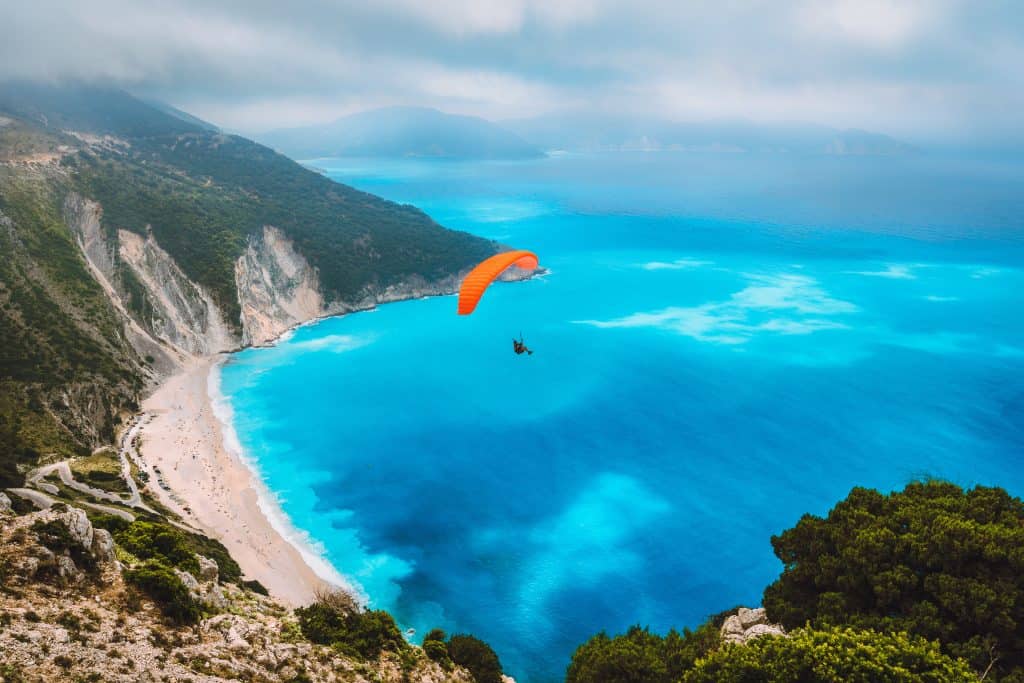
Flying Paramotors is one of the most exhilarating experiences that life has to offer. Soaring up at great heights excites the mind, gets your blood pumping, and makes your heart skip a beat. The heights at which you fly paramotors aren’t the only thing that makes paramotoring exciting though. Paramotors can travel at a good clip as well. Just how fast can paramotors go?
How fast can paramotors go, and what’s an average speed? Paramotors fly at 30 mph on average when flying in a small amount of wind. You can go 70 mph or more if you have a strong tailwind, but if you are going against the wind in a large wing, you may only travel 3-4 mph.
There are many other different things that can affect the speed of a paramotor though. For instance, the height at which you are flying can determine the kinds of winds you are likely to find.
The wing of the paramotor plays a large role in how fast the paramotor can go. Things like the size of the wing, whether or not the wing has trimmers, and if there is a speed bar equipped on the paramotor will change the max speed of the paramotor, as well as how it flies under normal conditions.
The age of the paramotor, the experience of the pilot, the thrust of the engine, all of these things affect the potential flight speed of a paramotor. Let’s talk about these things that change the speed of a paramotor,
Speeds at Different Altitudes
Speeds Close to the Ground
When flying close to the ground, wind speeds tend to be slower, as there are more obstacles to slow the wind, such as mountains, trees, and even other winds. Different oppositional winds will be more turbulent with each other closer to the ground and slow each other down.
This effect is minimized the farther up you go, as there isn’t as much influence from the axis of the ground acting as a barrier to the winds (the ground effectively channeling the winds together and the winds canceling each other out).
Speeds At High Altitudes
There is less friction and turbulence between winds as you go higher up. You can travel significantly faster if you are flying above 10,000 ft (depending on wind direction) than you can on the ground. Though it is cold and there are slightly lower oxygen levels at that height, the jetstreams of wind up there are powerful.
Tucker Gott and his Strategy to Win
There is a paramotor race called The Icarus Trophy. One of the most recent winners was a popular YouTuber by the name of Tucker Gott. Tucker had to travel around 1,000 miles on his paramotor to get to the finish line of the 2017 Icarus race.
Not only did Tucker win the race, but won it by a margin of two days before any of the other participants did. How did he win the race so thoroughly?
Redditor “FatMagic” had this to say about Tucker’s victory and the aspects that went into his insane speed:
“My best guess after obsessively observing & following the race maps and stats…
1 – He flew above 10,000 ft for much of the first leg, catching a good tailwind and cruising around 50-60 MPH. This was aided by the use of a speed bar on the first day (which he stopped using after, it was too tiring). His competitors during this leg were maybe pulling 25-35 MPH. They also flew much lower. Around 5000 ft and they complained of the cold temps even at 5k, and didn’t understand how Tucker would want to fly up at 10k – where
is was around freezing (26-32 F).2 – He used every ounce of daylight to fly. Only landing to refuel (food & gas) & bathroom breaks. He would be up early and off as soon as it was legal (30 mins before sunrise & after sunset w/ a strobe on his motor frame), and would land as late as legal. Many of his competitors would rise later and take their time getting up off the ground in the morning.
3 – He flew during some sketchy conditions (salt flats mid-day thermals being the worst), but handled it extremely well. Luckily he dodged much of the worse weather that his competitors ended up facing.
4 – A
couple competitors had bad motor outs (in the mountains!), bad launches (destroyed props!), and even flew into powerlines (in a chicken suit!). So honestly, his competitors ended up behind in the race by these mishaps. If those issues hadn’t happened, maybe it would have been a little closer (not by much though).
Crazy part is – Tucker could have ended the race a day sooner if he took the route that Canyon was taking (basically due south). But he decided to take the “safer” and less risky route and swing west to Jackpot, and then southeast towards the salt flats.This race is in its’ infancy honestly, and Tucker just brought the bar up. This is not the end. Now due to the publicity that Tucker has brought to it, there will be more competitors in the coming
years, and much more competition. And it will be stiff competition. If Tucker continues to compete, he will not hold the Trophy for long.My 2 cents on Icarus (which I thoroughly enjoyed!)”
reddit.com, Comment by FatMagic
What Does the Speed Bar Do?
What Is the Speed Bar?
A speed bar is a foot control that can change the speed of the paramotor. It attaches to the harness and connects to the canopy via pulleys. Speed bars can be tiring to use for long periods of time, as they are foot controls that need to be pressed down kind of hard.
Use of trimmers will increase your speed as well, but the use of trimmers and a speed bar at the same time is dangerous. You can go very fast, but the use of both the speed bar and trimmers has a high risk for a frontal stall.
How does the Speed Bar Make You Go Faster?
The speed bar changes the angle of the wing by use of pulleys and lines. When the speed bar is used, the angle of attack is decreased, and the wing doesn’t drag as much in the wind. Though the rate of elevation is decreased, speed is increased.
Wing Collapses at High Speeds
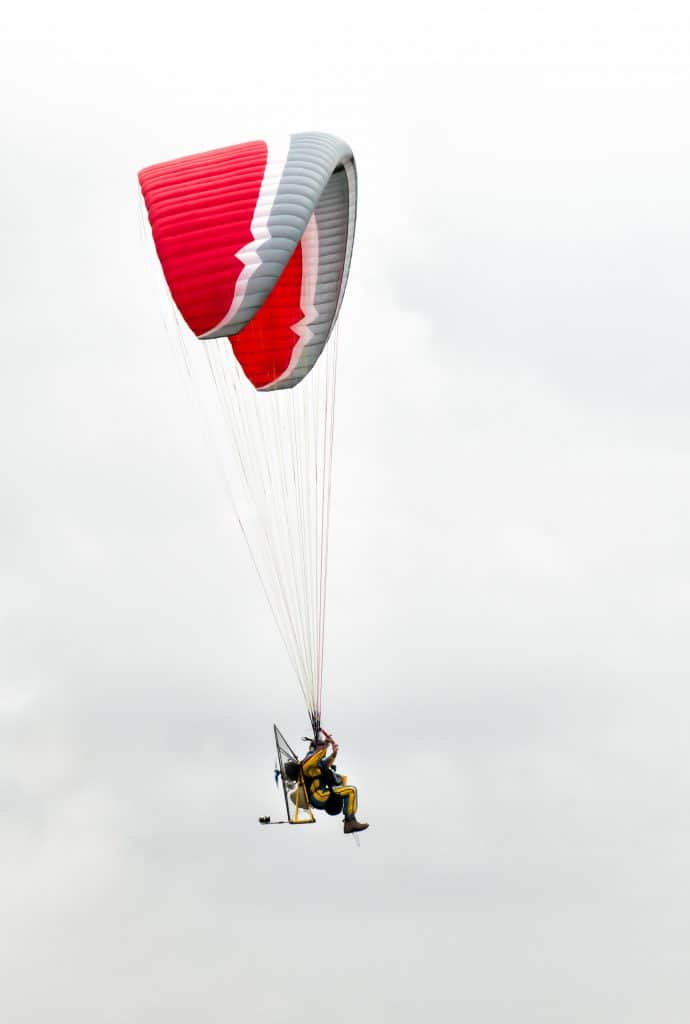
Turning at High Speeds
When traveling at high speeds, you have to be careful with how hard you turn. Though it may seem like fun, it can be quite dangerous to yank the lines and try to turn sharply.
In fluid dynamics, there is a term called “angle of attack.” In aeronautics, this is a term used to describe the angle that the wing is cutting through the air.
Paramotor wings will pretty typically have an angle of attack that is above the airstream. However, turning at a high speed can change this.
Turning changes the angle of attack for one side of the wing. The intent of this is to offset the balance of pressure in the wing. This isn’t a problem until air starts pushing in on the top of the wing. Turning sharply/quickly at high speeds can do this, and the pressure will collapse the wing.
Especially while flying in turbulent winds, be sure to use caution. A collapsed wing is manageable, but definitely something to be avoided.
Thermals and how to Safely Enter/Exit Them (At High Speeds)
There are three tips that I can give when it comes to flying in thermals at high speeds that all fall under one rule, be a Proactive Pilot:
- Be a Proactive Pilot, Use Your Breaks: Don’t be complacent and just go for speed. There are real dangers in paramotoring, and it’s up to you to keep yourself safe. Use the brakes, not only to slow yourself down but to avoid and breakthrough wing collapses before they can completely happen.
- Be a Proactive Pilot, Weight Shift: Some pilots get too relaxed in their flights and forget that weight shifting is an important part of being an active pilot. Letting the air toss you around, especially entering or leaving a thermal at high speeds, is a recipe for disaster. Constantly be watching your weight shift, and be ready to adjust it.
- Be a Proactive Pilot, Fly Level: Sure, you can be an active pilot. Sure, you can weight shift more often. But what are we being proactive and remembering to weight shift towards? Leveled flying.
Flying level is most likely to help you stay safe. Thermals are turbulent spots, and dangerous to be in at high speeds. Flying at a strange angle is likely to collapse your wing.
Can You Fly Too Slow?

You have to have some movement (or at least wind in your wing) to fly your paramotor. However, barring that, there’s really nothing stopping you from flying nice and easy. There are a few things though that can come from incorrectly trying to fly slowly that can become issues.
Pumping the Brakes: Cause for Wing Collapse
Sometimes, new pilots will pump the breaks because they are afraid of going too fast. This is actually quite dangerous, as it can cause a stall and has the potential for a wing collapse.
New pilots should be aware that pumping the breaks is not a good idea. You should be confident in what you are doing in the sky, and not be afraid of a little speed.
How to Fly Slowly and Safely
Don’t pump the breaks, or turn sharply for only a moment and expect it to work as well as being concise, slow and deliberate with your actions. You can fly slowly perfectly safely, but it’s best to be sure that all your actions are drawn out.
Get good at thinking ahead, and think about what move you want to be executing 3 seconds from now. Paramotors have decent reaction time to your inputs, but it’s not always instantaneous. Just keep that in mind, and you’ll be perfectly safe while flying.
Paramotoring Clothes to Wear When Planning to Travel Different Speeds
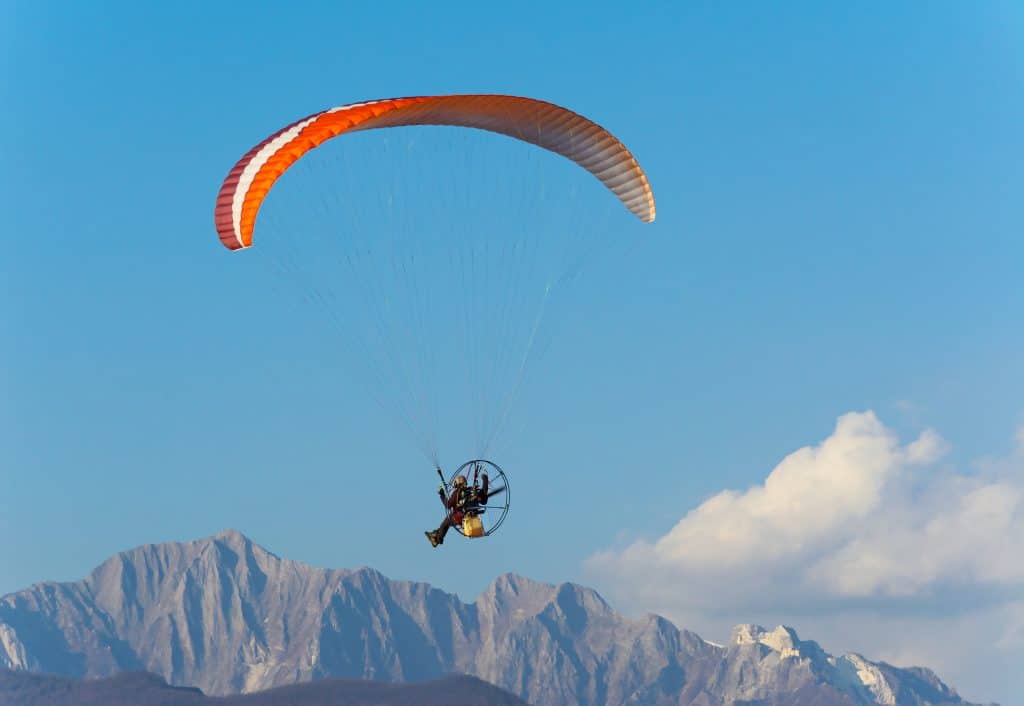
When thinking about what clothes you should wear at different speeds, there are other things to consider besides just the speed that can a
Considerations:
Altitude –The higher up that you get when paramotoring, the faster you can go, but the colder it will tend to be. Layers are important to stay warm. Depending on just how high up you plan on going you should consider wearing different clothing than you normally wear.
Snow Pants and a heavy jacket are good, but those things alone may not cut it. Consider compression undergarments if you plan on flying at higher altitudes. Higher altitudes provide unique opportunities to go insanely fast, but can also be dangerous for your health.
“The main reason compression clothing exists is to improve blood circulation during physical exercise. The goal is to compress muscles so that they, while contracting, constrict veins. This then enables blood to reach the heart more easily while improving muscle oxygenation. Another benefit is that compressive apparel prevents the buildup of lactic acid in the muscles during training/competitions, and helps the body to recuperate more rapidly after it and reduces muscular inflammation.”
altitude-blog.com
The combination of compression undergarments with a thick outer layer should help you stay warm and oxygenated when getting that boost of speed from flying high.
Temperature – If it’s cold outside, you should be cautious and careful. Flying at high speeds can sap any heat you have away, and flying at low speeds if it’s cold enough isn’t a fun experience either.
If you decide to fly at high altitudes when it’s already cold outside and you aren’t prepared, that could be a dangerous situation and would not be fun.
Knowing how cold it is outside should let you have a good idea of what to wear in many situations, but especially when you plan on flying quickly. Wind can blow all the heat out of you, no matter how bundled up you are.
If it’s hot outside though, it should feel amazing to fly your paramotor at high speeds, the wind cooling you off as it blows over you. Just be mindful that even if you can handle the temperature while you’re on the ground, flying (especially at higher speeds) will cool you down.
Wind Speeds –When flying paramotors, wind is something that you become well acquainted with. In low wind speeds, when you’re flying at slower speeds, you might not need to bundle up all that much. However, if you are flying in higher winds you can get going pretty fast.
Something to consider purchasing if you fly a paramotor is a windbreaker. Windbreakers, like the
Planned Speeds – Consider the speeds that you plan on flying at. If you are planning on going faster, be more prepared. If you’re just going for “a leisurely fly through the park”, you might not need to pull all the stops on dressing warmly.
On the other hand though, it’s a good idea to be prepared should you decide you want to go faster. It might be nice to have a extra sweater/jacket with you on the paramotor, and a spare heavy pair of gloves.
Humidity –At higher altitudes, humidity makes very little difference in what you should wear. However, if you are flying closer to the ground, humid air plus cool temperatures can make flying uncomfortable, and the faster you fly, the worse it seems to get.
One solution to this is to buy a windbreaker. Just like it blocks wind, a windbreaker will block moisture in the air as well, keeping your clothes underneath nice and dry.
Most windbreakers are waterproof in this way, so a windbreaker is a really good investment for paramotoring.
Relationship Between Paramotor Speed and Paramotorist Experience
Newer Pilots Fly Safer Wings
Newer pilots to the sport of paramotoring are typically drawn to the safer paramotors. These paramotors are not as fast but are less likely to have wing collapses or other dangerous issues.
Because newer pilots are more likely to buy these paramotors than more dangerous ones, newer pilots tend to fly slower than more experienced pilots.
More Experiences Pilots Tend To Fly More Competition Tier Wings
Those who have been into paramotoring for a while are aware of their own skills and abilities and have developed them to a point where they can safely fly the more dangerous but faster paramotors.
Though some more experienced fliers will still want to fly safer paramotors, many will choose to fly faster, more reflexive paramotors.
Paramotor Wings and Their Effect on Speed
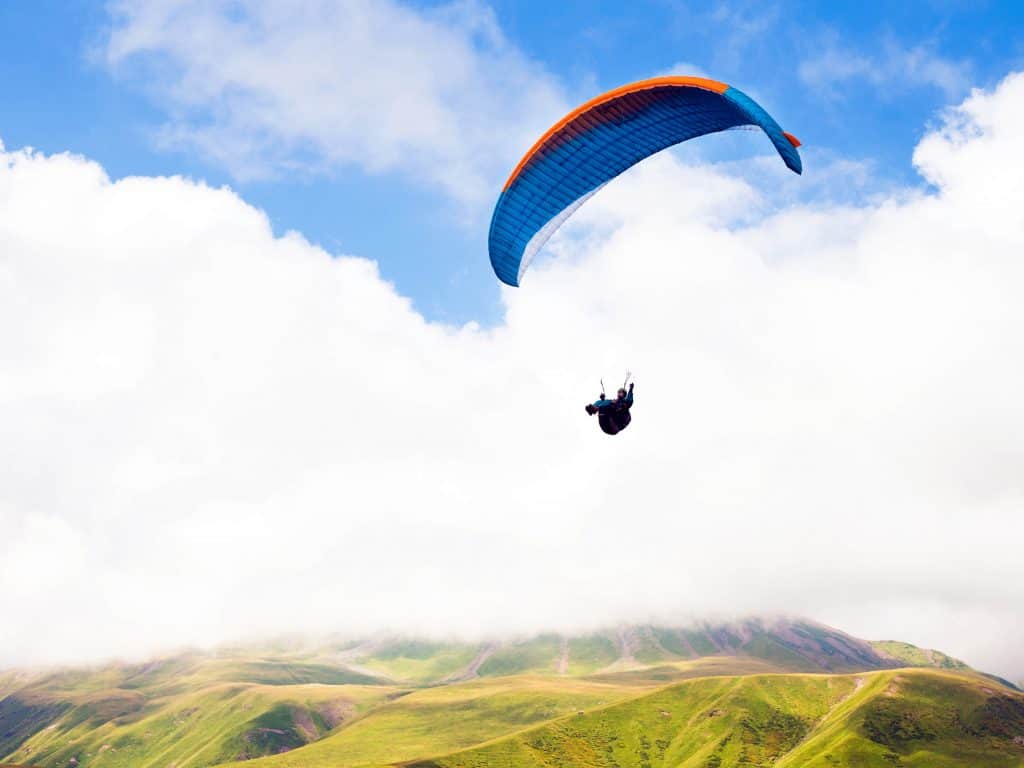
Larger Wings
Paramotor wings that are larger in size tend to do two things.
- Catch the wind with a higher efficiency
- Have more stability
Larger wings on paramotors have more surface area, and so can catch more of the available wind. This is great when you have a wind coming from behind that can propel you forward. You can pick up a lot of speed quickly by doing this.
However, the opposite is also true. If you have a wind coming at you from the direction you are headed, that’s more wind that is pushing you back.
The stability of the larger wings on paramotors has it’s pluses and minuses as far as speed is concerned. In turbulent winds, the larger wing has greater focus and can move more quickly (though if a large consistent wind comes along out of nowhere, you could be in for a bumpy ride).
Smaller Wings
Smaller wings have the advantage over smaller wings only in that they are more reflexive, and that they have less surface area to push back against when flying into the wind. Aside from that, larger wings are typically the better option for speed.
The Speeds of Two-Stroke, Four-Stroke, and Electric Engines
Two-Stroke Engines
Two-Stroke Engines are by far the most common type of paramotor engine. They have a good amount of thrust and are light. They are solid engines and you should consider one of these for your normal paramotor flying experience.
Four-Stroke Engines
Unlike Two-Stroke Engines, Four-Stroke engines are heavy powerhouses. They weigh more than the two-stroke (which boosts stability) and can provide more thrust than two-stroke paramotors.
Four-Stroke Paramotors are good for traveling through turbulent winds at a good clip, but the lightness of the Two-Stroke gives it an edge in speed over the Four-Stroke in most other situations.
Electric Engines
Electric Engines are not engines that were built for speed. They don’t have good lasting power or thrust. The redeeming quality of electric engines is that they don’t require nearly as much maintenance as the Four-Stroke or Two-Stroke Engine.
It’s slow, but if you use it right, it can save you money in the end.
How Flying a Used Paramotor Affects Speed
Over time, paramotors can deteriorate. Even with constant and consistent maintenance, every paramotor has its decline. Older engines tend to only be able to output a portion of their original thrust. Depending on the engine and the age, some engines can lose around 20 lbs of thrust.
However, this really isn’t the end of the world. Any paramotorist can tell you that the thrust of the motor matters a lot less than the capability a pilot has to capture and harness the wind.
Using your wing correctly and efficiently makes any deficit of thrust inconsequential. Though there may be a
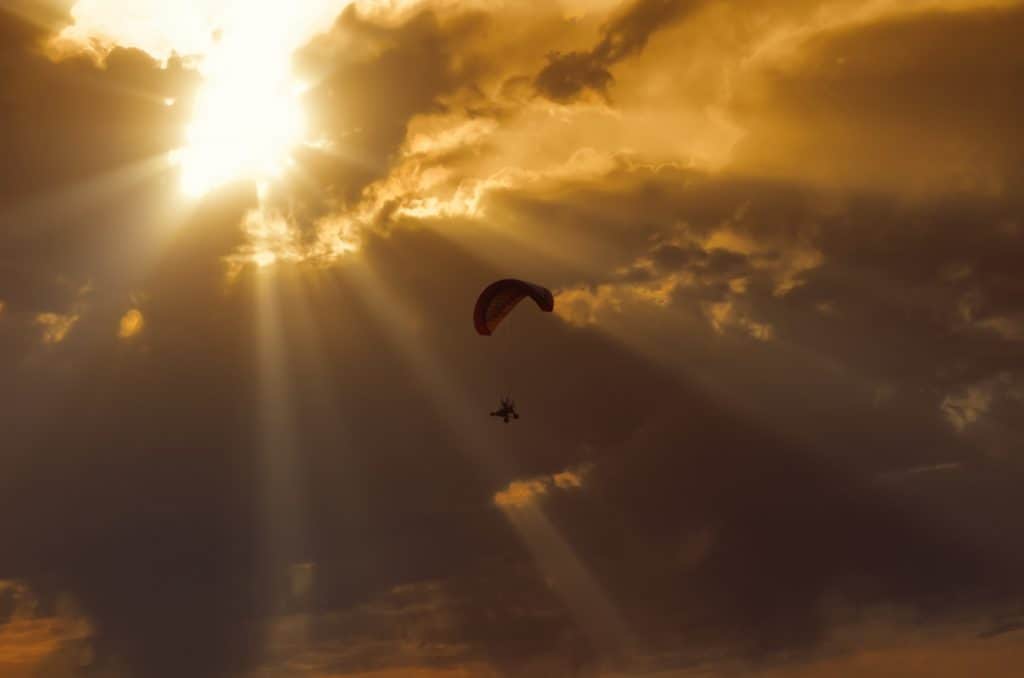
Related Questions:
Which is Safer, Paramotoring or Paragliding? Paramotoring is safer than paragliding. Paragliding has nearly twice the fatality rate of paramotoring. Paramotors heightened the ability to adjust course makes them safer to learn. However, if the pilots of either paramotoring or paragliding are experienced, the risk is about the same.
How High Can a Paramotor Fly?Paramotors can be flown to a height of 18,000 feet, but the air is dangerously thin. Most paramotor flights only reach heights of 1000 feet. It is generally safer to fly high than low to the ground. When flying low, the reaction time is reduced if a problem arises before hitting the ground.
What are the Primary Causes of Accidents on Paramotors?The most common cause of accidents is pilot error (meaning that there were no equipment failures accompanying the pilot error). The second most common cause of paramotoring accidents is mechanical failure. The third most common cause of paramotoring accidents is bad weather.

